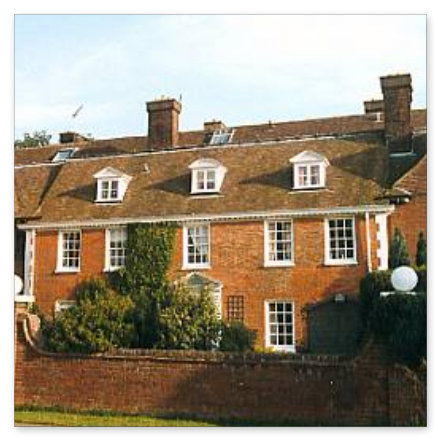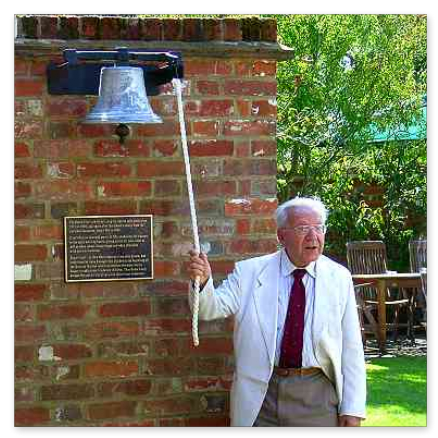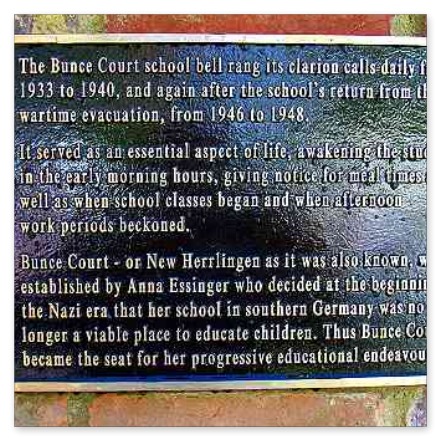Anna Essinger and the New Herrlingen School
The following text on the history of Bunce Court School is from Michael Luick-Thram's dissertation "Creating 'New Americans': WWII-era European Refugees' Formation of American Identities" - Bunce Court.
Upon finishing a German education, Anna Essinger of Ulm went to America, became a qualified teacher and lectured at Madison's University of Wisconsin, where she also ran a student hostel. After the first world war she returned to Germany with a Quaker-sponsored Kinderspeisung program and opened Sozialen-Frauenschulen-community-focused schools for women - near Stuttgart.
In 1911 her sister and her general-practitioner brother-in-law had established a children's hostel in Herrlingen, a Swabian village near Ulm; wishing to found a boarding school for those children, Essinger joined them. With the help of two other sisters, she opened the school in 1926 with 18 pupils. In 1927 an Education Ministry report described her as "extremely competent" and said she taught in a "very skillful, fresh and stimulating way, exploiting the material with a dedicated precision linked with resolute practice".
Essinger's progressive school thrived until 1933. A Jew, Essinger received notice after Hitler's ascendancy to power that her first pupils - who were then the age for it - would not be allowed to sit the Abitur, the German state school-leaving examination. Furthermore, for the Führer's birthday in April 1933 it was announced that the Nazi swastika was to be flown over all schools: Essinger obeyed the order but sent the children on a day-long outing. A nephew later recalled: "A flag flying over an empty building could signify so much, and that is what my aunt intended".
Recognizing that her school had no future in the New Germany, in summer 1933 Essinger - then 54 - took 13 of her pupils to England and re-opened the school in Bunce Court, a country estate at Otterden in Kent. Having been denied a chance at the Abitur in their own country, the pupils sat the London Matriculation and nine passed - three with distinction! With help from two sisters, Essinger proceeded to develop a school which closely reflected her dynamic personality.
According to one Kent historian, Anna Essinger was the - then - English idea of a typical German headmistress, short, stout, with very thick spectacles, a brisk and efficient manner, 'homely' [in the British sense of the word] and very kind to the children, but a strict disciplinarian to teaching staff and pupils.
Autumn 1933 found another 65 pupils and their teachers fleeing Nazi Germany via three separate routes so to avoid official notice. Along with these new arrivals came much work. Part of the school's curriculum was practical work and in the following two months pupils had plenty of that, as they had to work in the house and garden.
A Committee of Friends organized to assist the school and erected a big wooden dormitory in the grounds for twenty senior boys. Even so, the children suffered from crowded living conditions that first winter. Some contracted diphtheria or scarlet fever; one boy died in November from polio, causing further anxiety in following months whether others might develop it, so Bunce Court was put into isolation for weeks. Provisions were left at the gates and short meetings with parents were restricted to the open air.
Although at first rough, conditions at the school eventually improved and a state of normality took shape. As the situation in Germany deteriorated, the school increasingly became home to Jewish youth sent abroad by worried parents; the children's unsettled lives and Essinger's progressive pedagogy created an atmosphere of community-based scholasticism.
Still, even in such a self-contained, thriving environment, events beyond the garden gate impacted everyday life, as the school body included Jewish refugee children first from Germany, then annexed Austria and occupied Czechoslovakia, followed by children from Poland and Hungry. As a group, they lived in "new-found security as 'citizens of the United Europe of the future'". Some were almost ill with homesickness and the older children anxious for parents, brothers and sisters left in Germany. A Quaker worker told...of parents' agony of mind who could only choose one of several children to go to England for safe education and which to select - the most brilliant, most fit, or one most vulnerable and unlikely to survive?
In Kristallnacht's wake Essinger helped Jewish families leave Nazi Germany. She had two new dormitories built at Bunce Court and even billeted children with local families. Eventually the need became to be so great that she and the staff barely could respond to it, for as conditions worsened in Germany and the number of refugee children swelled, demand on the school's resources grew. The school's council advised against taking children without definite financial arrangements, though the school "always had up to a dozen children" without them. Many children were taken "on good faith", in the hope that parents would pay when they could or themselves escaped. Another problem involved locating British teachers able to deal with emotional needs of Jewish children taken from parents, homes and native country. At that time... Britain was still a peaceful, secure country and few realised what was really happening in Germany and were thus unable to comprehend why Anna [brought the] children out of Nazi Germany.
Sometimes, though, "problems" at the school consisted not of spacial or health or psychological limitations - but lingual ones. The official language at the school had to be English in deference to the children's futures, but German remained the de facto lingua franca - a state which caused struggles as well as smiles. In an attempt to enforce the use of English, new British teachers were told they must not learn any German for a year - but they usually did, as the unofficial language of the school was still German for a considerable time. One of the teachers, however, devised a way of reminding the children of the rule of only English at meal times by hanging a miniature Union Jack over the dining-room mantel; at the sound of a German word the teacher pressed a button connected to a light bulb, which illuminated the flag and buzzed a bell. Another daily event that also took place at meal times was a brief "touching of hands" around the table. This was intended to unite the whole body of the school for a short time before meals - "a sort of silent, non-religious grace-before-meals". Furthermore, there was no school uniform, as anything which reminded staff or pupils of "uniformed Nazi Germany was anathema".
Indeed, at least for them personally, Nazi Germany was behind the young exiles-necessitating them to adapt to a new country and culture. To that end Essinger emphasized participation in groups with foci beyond the front lawn. The school welcomed guest speakers from the League of Nations Union - for example - and from the Workers' Education Association. From the latter came a local mail carrier one cold, rainy night to "face what seemed an endless sea of children's faces". Describing himself as a "bundle of nerves", he "was nearly overcome with stage fright", but managed to get through his "party piece".
On a larger scale, as soon as the school had become firmly established its contacts with the local community increased and "its fame spread further afield". The staff decided in summer 1934 to hold an Open Day in the last week of July. During it the children performed the Aristophanes play "Peace" - with the stately manor house as background - and made all of the costumes and props. Some 250 visitors came to see the school and the play -among them Lord Samuel, who in a address welcomed the children to England. Due to this exposure children were invited to stay with host families for holidays. Open Days were held every year up to and after the war.
The war, however, would disturb more than merely the amicable Open Day. As of September 1939 the owner of the estate fretted how the war might mean the appropriation of Bunce Court and end her income from it, so the Committee of Friends organized for Essinger to purchase the property from her. Then, the following May, with the advance of the Wehrmacht into France all German male staff and pupils over 16 landed in "enemy-alien" internment camps - soon followed by the school's cook and girls over 16.
In June 1940 military authorities issued the school three days' notice to leave the premises, as it had been declared a Defence Area: the army had requisitioned Bunce Court. After intense pleas the government reconsidered - granting a week's notice to move an entire school! Not surprisingly, a suitable replacement could not be found, so the school body split - with the smaller part joining another school and the larger part moving to empty Trench Hall in Shropshire, where the school stayed until the war's end.
After "much effort" the school re-opened at Bunce Court in June 1946. Immediately after the war it accepted a number of children and young people who had been prisoners in Nazi concentration camps or had similar wartime backgrounds. This, among the underlying and unavoidable fact that eventually there would be no more Continental children coming from Europe... Possibly it was at this stage that Anna Essinger felt the original purpose of the school in England was no longer relevant; another may have been that [at almost 70] she was now elderly and considered her work done.
Bunce Court school closed in 1948 - having served some 900 pupils. Indeed a unique place, it belonged to a specific time. It's rich legacy, however, survived in the form of Continental children assimilated into "British" adults who made important contributions to their adopted homeland. Not only Bunch Courtians, however, went on to lead lives marked by achievement.
Read more on this on Michael Luick-Thram's web pages.


